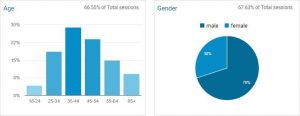The pressure on suppliers to adapt to B2B mobile buyer habits is growing. Mobile now accounts for almost 30% of B2B eCommerce sales and, with general mobile usage now outpacing that of desktop, that figure is only set to grow. More than ever, it’s vital that suppliers of all stripes are making use of mobile technology to keep up with new demands and expectations.
The good news is that the trend towards mobile carries with it a range of fresh opportunities. With the ability to operate outside of the confines of a traditional desktop browser, suppliers can now take advantage of new features like push notifications, social integration and mobile payments, to name just a few examples.
In this post, we’re going to look at four important ways that mobile commerce technology is shaping the B2B eCommerce sphere.
4 Ways Mobile Commerce Technology is Shaping B2B eCommerce
1. Feature-rich apps and mobile stores.
Many suppliers are choosing to package their catalog and checkout functionality in the form of a native mobile app. This allows for a new degree of personalization. Suppliers can offer a range of features, like customizable dashboards and personal order histories, tailored for mobile users.
The fact that the length of time people are spending on their phones per session is increasing reinforces the point that the mobile experience is growing more immersive. This feature-richness, which is already present in many B2C retail apps, is beginning to characterize B2B mobile technology.
At the other end of the spectrum, suppliers themselves are finding that it’s easier to manage their sales and operations from handheld devices. Mobile approval workflows and real-time customer insights, for example, have allowed reps to work whilst on the go, with the ability to confirm orders, track target progress and update catalogs whenever the need arises.
2. Effortless integration.
The interesting thing about mobile phones is that they have embedded themselves into our day-to-day lives in a way that desktop computers never could. We’ll never order a taxi outside a nightclub or plan a GPS route using our laptops, yet we do these things on our smartphones as a matter of habit. All of these new capabilities, from location tracking to contact list syncing, can potentially improve the mobile B2B experience.
Though it is still evolving, integration is starting to drive greater speed and efficiency. Mobile wallets provided by services like Apple Pay, Google Wallet and Square, for instance, can be used to streamline the checkout process, whilst location services can provide local real-time stock level information. Barcode scanning can even enable buyers to make snap shop-floor purchases.
3. New marketing and advertising opportunities.
As mobile gains prominence, new advertising opportunities are presenting themselves. It’s now possible, for example, to send marketing messages to your users, whether it’s to encourage them to finish their purchase or try out a new promotion. These kinds of features are growing in number, with the ability to target people based on their browsing history and their location.
The trend also applies to social sharing. According to one study, a colossal 75% of B2B buyers are influenced by social media. This trend follows on closely from the second one in the sense that mobile eCommerce technology works seamlessly with an array of social sharing functionalities on mobile devices.
It’s unlikely that retailers will want to tweet about their latest bulk order, but it’s important for suppliers to realize that their app or mobile website is inextricably tied up with this sharing ecosystem. Consider a clothing retailer who wants to post images of a new item to their social media following, or a marketing executive who wants to share information about a new promotion to their LinkedIn following. One study conducted by Dell indicates that 57% of B2B buyers monitor existing conversations about products before making a purchase.
4. Analytics services are providing mobile-specific data
The importance of data in the modern B2B eCommerce space can’t be understated. Suppliers are using in-depth analytics tools to inform everything from the way they design their user interfaces to the topics of their blog posts. Customer-centric experiences, which are built on a recognition of the unique needs of each individual user, are becoming the norm for B2B buyers. The B2C world, with its customer histories, recommended purchases and personalized subscription options, is providing the template in this regard.
The ability to design the kind of buyer journeys that B2B clients are demanding is dependent on the availability of platform-specific data. Big analytics companies like Google, along with a host of smaller providers, are now offering extensive data about mobile and in-app usage.
The key point to bear in mind here is that buyers purchasing through mobile devices commonly have a different set of needs to those that use desktop portals. Orders are often made quickly on the shop floor, for example.
So, what do you think about our analysis of the impact of mobile commerce technology? Leave a comment below and let us know!
Digital & Social Articles on Business 2 Community(68)





